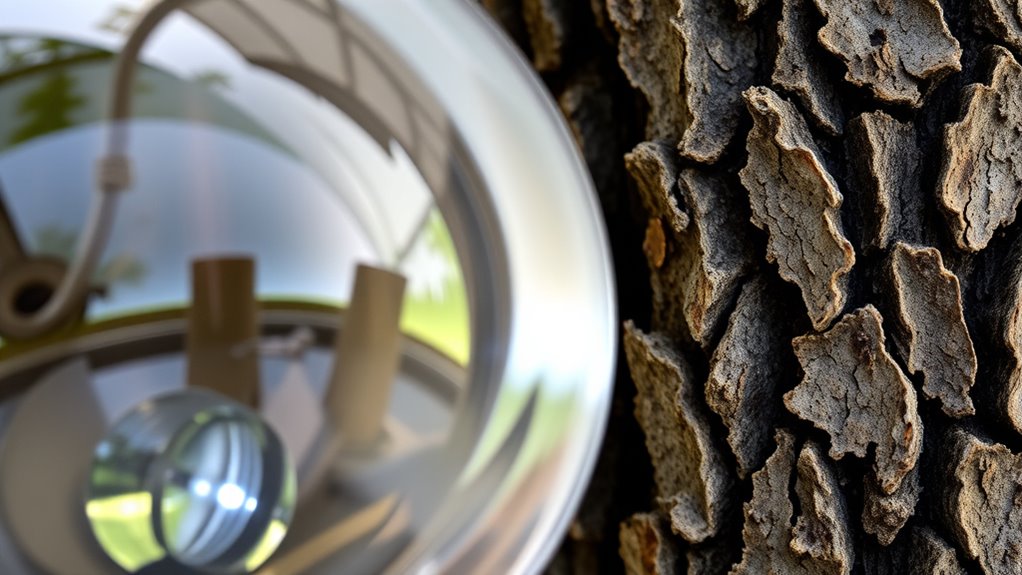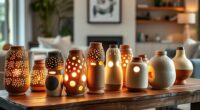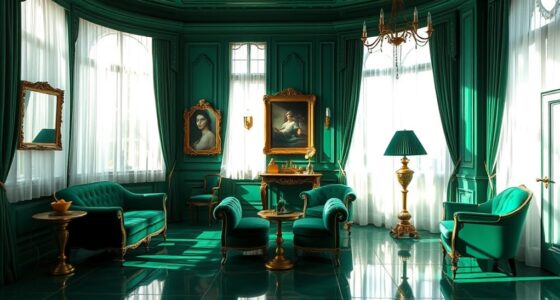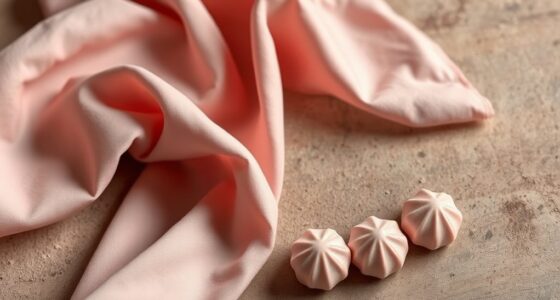Pairing smooth and rough surfaces enhances your design by engaging the senses and creating visual interest. Combining textures like polished marble with rugged wood or sleek leather with chunky knits adds depth and contrast, drawing attention and evoking emotional responses. Using these opposing textures thoughtfully balances harmony and excitement in your space or style. To discover how to master this technique effortlessly, explore ways to incorporate these tactile contrasts effectively.
Key Takeaways
- Combining smooth and rough textures creates visual and tactile contrast, enhancing sensory engagement and interest in design.
- Use balance and strategic pairing to evoke specific emotional responses and highlight focal points effectively.
- Layering and overlapping textures at varying scales add depth and prevent visual clutter for cohesive aesthetics.
- Consider material compatibility and durability to ensure practical, long-lasting surface contrasts.
- Incorporate contrasting textures to stimulate surface tension, inviting both visual and physical interaction.
The Science Behind Texture Contrast
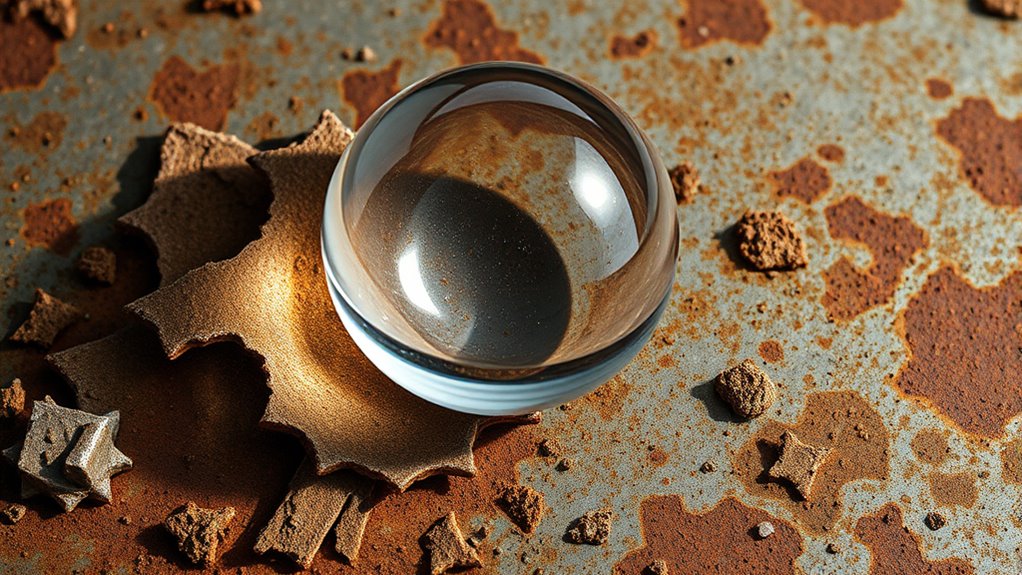
Understanding the science behind texture contrast reveals why certain combinations excite our senses. Your sensory perception is highly responsive to tactile stimulation, which influences how you experience different surfaces. When you encounter both smooth and rough textures together, your brain processes these differences in a way that heightens awareness and interest. This contrast creates a dynamic tactile experience, engaging your senses more fully than uniform surfaces. The variation in tactile feedback triggers neurological responses that make textures feel more vivid and compelling. Additionally, high refresh rates in displays can further enhance visual contrast and clarity, complementing tactile differences. By understanding this, you can intentionally pair contrasting textures to enhance sensory engagement in your environment or designs. Ultimately, recognizing the role of tactile stimulation helps explain why contrasting textures evoke such strong sensory reactions, making your experiences more memorable and stimulating.
Techniques for Combining Smooth and Rough Surfaces
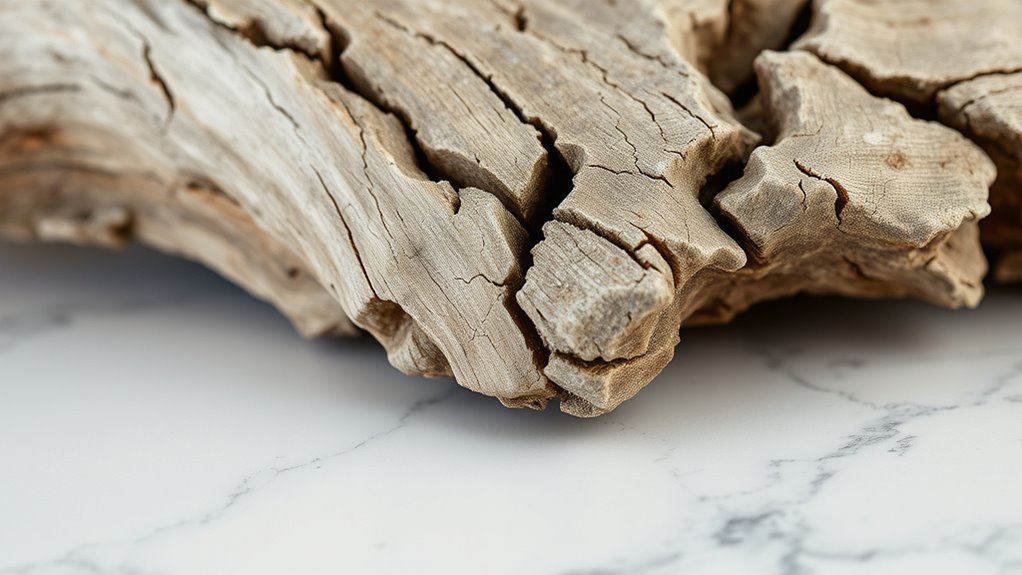
To create striking designs, you can contrast smooth and rough surfaces intentionally. Layering these textures adds visual depth and keeps the viewer’s eye engaged. Experimenting with different combinations helps you achieve a balanced and dynamic look. Incorporating texture pairing can also evoke specific tactile responses and enhance the overall aesthetic.
Contrasting Textures in Design
Have you ever wondered how contrasting textures can elevate a design? When you combine smooth and rough surfaces, you create visual interest and tactile engagement that energizes a space. To achieve effective contrasting, consider these techniques:
- Balance with symmetry, pairing rough textures with smooth ones to maintain harmony.
- Highlight focal points by contrasting textures, making certain elements stand out.
- Use scale wisely—large rough surfaces against smaller smooth details enhance textural harmony.
- Experiment with unexpected pairings—combine matte with glossy finishes for a surprising effect.
- Incorporate rustic decor elements to emphasize the contrast between aged, textured surfaces and polished finishes.
Layering for Visual Depth
Building on contrasting textures, layering different surfaces adds depth and richness to your design. By carefully combining smooth and rough materials, you create a sense of surface tension that draws the eye and invites tactile exploration. Tactile layering involves placing these textures in a way that enhances visual interest without overwhelming the senses. For instance, pairing a sleek, polished surface with a rugged, coarse element highlights their differences while creating harmony through contrast. Experiment with overlapping textures at varying heights or depths to amplify visual depth. This approach encourages viewers to engage physically and visually, making your space more dynamic. When layering, consider how the textures interact and how the tactile experience influences perception, reinforcing the overall design narrative through strategic surface tension. Incorporating visual harmony by balancing contrasting textures ensures the design remains cohesive and captivating.
Inspiring Examples in Interior Design
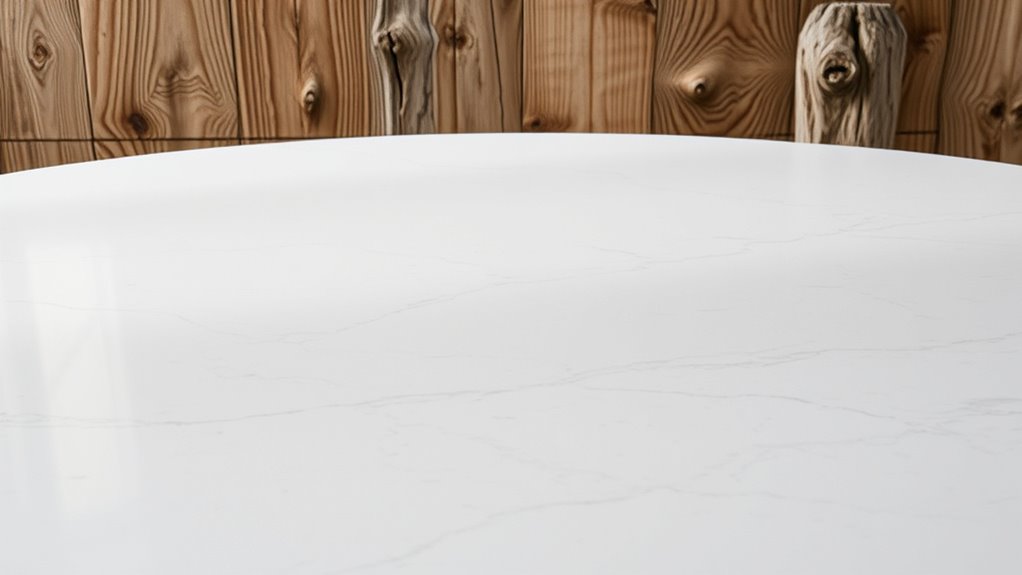
Ever wondered how texture pairing can transform a space into something truly inspiring? It’s all about creating textural harmony and engaging tactile interplay. Here are some standout examples:
- Combining sleek marble countertops with rough-hewn wooden accents adds visual and tactile contrast.
- Velvet cushions paired with coarse woven rugs create a cozy, inviting atmosphere through textural harmony.
- Matte-finish walls contrasted with glossy metal fixtures enhance tactile interplay, elevating modern aesthetics.
- Exposed brick walls combined with smooth plastered surfaces generate a layered, dynamic look.
- Recognizing the symbolism in textures can deepen the emotional impact of a design, making spaces more meaningful.
These examples show how thoughtful texture pairing can turn ordinary spaces into inspiring environments, highlighting the power of tactile interplay to evoke emotion and interest.
Fashion and Accessories: Playing With Textural Balance
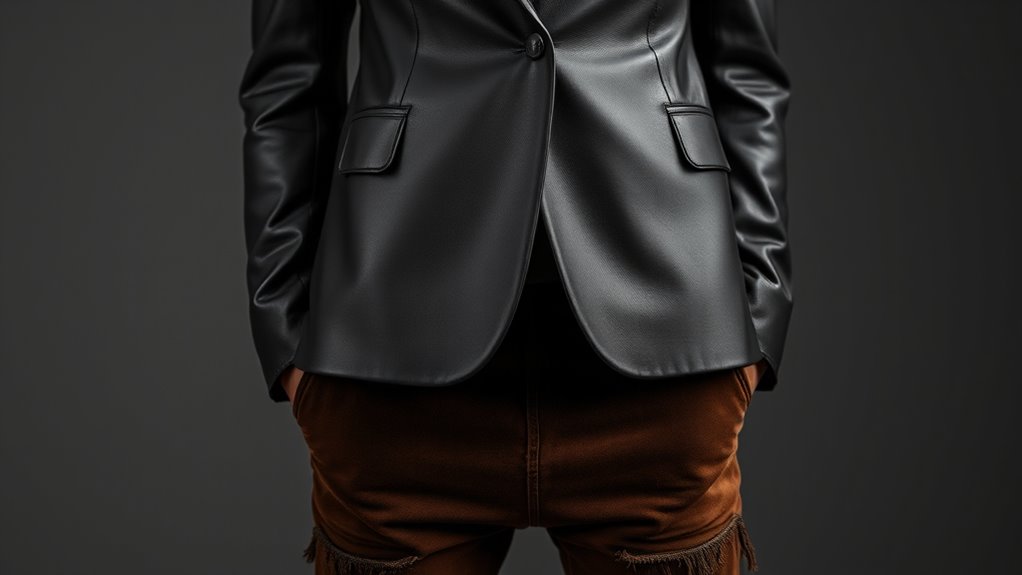
Playing with textural balance in fashion and accessories allows you to create visually intriguing and tactilely engaging outfits. By experimenting with fabric mixing, you can combine smooth, glossy materials like silk with rougher textures such as burlap or tweed, adding depth and interest. Surface tension plays a key role in how these textures interact visually and physically; contrasting surfaces create a dynamic tension that draws the eye. When you pair a sleek leather bag with a chunky knit scarf, you leverage these surface differences, making the overall look more compelling. This balance invites touch and visual curiosity, encouraging others to explore your style beyond just sight. Mastering surface tension through fabric mixing helps you craft outfits that are both sophisticated and richly textured. Additionally, incorporating antique pieces into your accessories can further enhance the tactile and visual richness of your ensemble, creating a truly layered and inviting aesthetic.
Material Choices for Effective Texture Pairing

Choosing the right materials is essential for creating effective texture pairings that enhance your outfit’s visual and tactile appeal. To achieve ideal textural harmony and tactile diversity, consider these options:
Selecting the perfect materials creates dynamic, tactile outfits that captivate visually and invite touch.
- Leather and suede — combine smooth leather with rougher suede for contrast.
- Wool and silk — pair textured wool with sleek silk for a sophisticated touch.
- Denim and linen — mix rugged denim with airy linen for casual yet refined appeal.
- Wood and metal — integrate warm wood with cool metal to add depth and tactile interest.
- Incorporating gear shifting techniques can help you maintain smoothness and control when navigating different terrain textures.
These material choices allow you to balance surfaces, creating engaging contrasts that invite touch and visual intrigue. Selecting the right combination helps you craft harmonious, dynamic looks that captivate through varied textures.
Tips for Incorporating Texture Pairing Into Your Projects
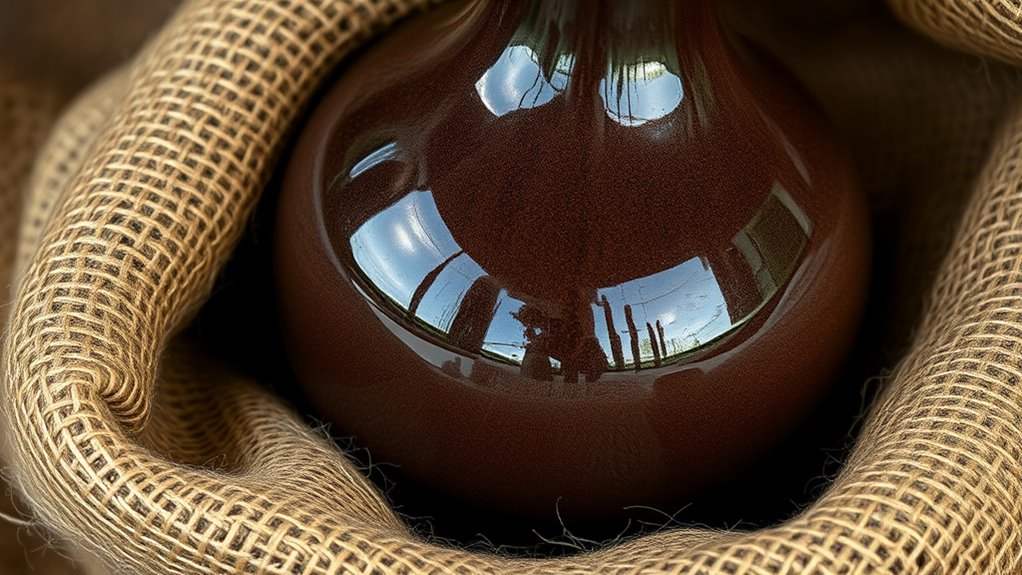
When incorporating textures into your project, focus on creating a balance between contrasting elements and harmonious ones. Make sure your materials work well together by considering their compatibility to avoid clashes. Paying attention to these points will help you achieve a cohesive and interesting textured design. Additionally, experimenting with materials diversity can add depth and visual interest to your overall composition.
Balance and Contrast
Achieving a balanced and contrasting texture pairing is essential for creating visual interest and harmony in your projects. A well-thought-out mix enhances the tactile experience and provides sensory stimulation that engages viewers. To do this effectively, consider these tips:
- Mix smooth and rough surfaces to create a dynamic contrast that draws attention.
- Use pairing techniques that emphasize differences without overwhelming, maintaining visual balance.
- Incorporate textures at different scales for added depth and tactile variety.
- Limit the number of contrasting textures to avoid clutter, focusing on strategic combinations.
- Incorporating sensory engagement by thoughtfully pairing textures can also evoke emotional responses and deepen the viewer’s connection to your work.
Material Compatibility
To successfully incorporate texture pairing into your projects, it’s important to guarantee that the materials you select work well together. Consider surface durability to ensure both textures withstand daily wear and tear. For example, pairing a rough stone with a smooth wood works well if you’re aiming for longevity and resilience. Also, think about cleaning considerations; some textures may trap dust or grime more easily. For instance, rough surfaces like brick or concrete require different cleaning methods than smooth surfaces like glass or polished metal. Matching materials with compatible maintenance needs helps preserve their appearance and functionality over time. Additionally, understanding self watering plant pots can inform your choice of materials to ensure they are suitable for outdoor or indoor use. By carefully evaluating surface durability and cleaning requirements, you can create a cohesive, durable design that enhances your space without sacrificing practicality.
Frequently Asked Questions
How Does Lighting Affect the Perception of Texture Contrast?
Lighting dynamics considerably influence how you perceive texture contrast. When you adjust the lighting angle or intensity, perception shifts, making smooth surfaces appear more polished or rough textures more prominent. Bright, direct light highlights surface details, emphasizing texture differences, while softer lighting minimizes contrast. You can manipulate lighting to create depth, drama, or subtlety, guiding viewers’ perception and enhancing the tactile quality of surfaces through strategic light placement.
Can Texture Pairing Influence the Acoustics of a Space?
Yes, texture pairing can influence the acoustics of a space. By combining smooth and rough surfaces, you can enhance sound absorption and control reverberation, improving spatial acoustics. Rough textures tend to diffuse sound, reducing echo, while smooth surfaces reflect sound more directly. Strategically pairing these textures allows you to create a balanced acoustic environment, making the space more comfortable for conversation and audio clarity.
Are Certain Textures More Durable When Combined?
While some textures are naturally more resilient, your choice depends on surface maintenance and material compatibility. Generally, rough surfaces tend to hide wear better, making them more durable when paired with smoother textures, which can be easier to clean but may show scratches. To guarantee longevity, select textures that complement each other’s maintenance needs and compatibility, allowing your space to stay appealing and functional over time without undue effort.
How Does Texture Pairing Impact the Overall Mood of a Room?
You’ll notice that pairing smooth and rough textures creates a dynamic visual harmony in your room, making it more inviting. The tactile contrast engages your senses, adding depth and interest to the space. This combination can evoke feelings of coziness or sophistication, depending on how you balance the textures. Overall, texture pairing influences the mood by making your room feel lively and balanced, encouraging both comfort and visual intrigue.
What Cultural Influences Inspire Innovative Texture Pairings?
Cultural influences like symbolism and regional craftsmanship inspire your innovative texture pairings. You might combine smooth ceramics from Japan with rough woven textiles from Africa, creating a meaningful contrast. These choices reflect local traditions and stories, adding depth to your space. By blending textures rooted in different cultures, you infuse your room with unique character, celebrating diverse artistic expressions and fostering a rich, global-inspired environment.
Conclusion
Don’t worry if mixing textures feels intimidating at first. With a little experimentation, you’ll discover that pairing smooth and rough surfaces adds depth and character to your space or style. Remember, even small touches can make a big impact. Embrace the contrast, trust your instincts, and have fun exploring new combinations. Before long, you’ll create dynamic environments that invite curiosity and admiration—proof that texture pairing is a game-changer you can master.

